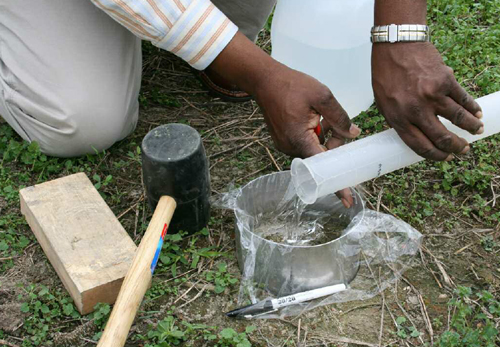Infiltration
What it is: Infiltration is the downward entry of water into the soil. The velocity at which water enters the soil is infiltration rate. Infiltration rate is typically expressed in inches per hour. Water from rainfall or irrigation must first enter the soil for it to be of value.
Why it is important: Infiltration is an indicator of the soil’s ability to allow water movement into and through the soil profile. Soil temporarily stores water, making it available for root uptake, plant growth and habitat for soil organisms.
Specific problems that might be caused by poor function: When water is supplied at a rate that exceeds the soil’s infiltration capacity, it moves downslope as runoff on sloping land or ponds on the surface of level land. When runoff occurs on bare or poorly vegetated soil, erosion takes place. Runoff carries nutrients, chemicals, and soil with it, resulting in decreased soil productivity, off-site sedimentation of water bodies and diminished water quality. Sedimentation decreases storage capacity of reservoirs and streams and can lead to flooding.
Restricted infiltration and ponding of water on the soil surface results in poor soil aeration, which leads to poor root function and plant growth, as well as reduced nutrient availability and cycling by soil organisms. Ponding and soil saturation decreases soil strength, destroys soil structure, increases detachment of soil particles, and makes soil more erodible. On the soil surface rather than in the soil profile, ponded water is subject to increased evaporation, which leads to decreased water available for plant growth.
A high infiltration rate is generally desirable for plant growth and the environment. In some cases, soils that have unrestricted water movement through their profile can contribute to environmental concerns if misapplied nutrients and chemicals reach groundwater and surface water resources via subsurface flow.
Conservation practices that lead to poor infiltration include:
- Incorporating, burning, or harvesting crop residues leaving soil bare and susceptible to erosion,
- Tillage methods and soil disturbance activities that disrupt surface connected pores and prevent
accumulation of soil organic matter, and - Equipment and livestock traffic, especially on wet soils, that cause compaction and reduced porosity.
What you can do: Several conservation practices help maintain or improve water infiltration into soil by increasing vegetative cover, managing crop residues, and increasing soil organic matter. Generally, these practices minimize soil disturbance and compaction, protect soil from erosion, and encourage the development of good soil structure and continuous pore space. As a short-term solution to poor infiltration, surface crusts can be disrupted with a rotary hoe or row cultivator and plow plans or other compacted layers can be broken using deep tillage.
Long-term solutions for maintaining or improving infiltration include practices that increase soil organic matter and aggregation, and reduce soil disturbance and compaction. High residue crops, such as corn and small grains, perennial sod, and cover crops protect the soil surface from erosion and increase soil organic matter when reduced tillage methods that maintain surface cover are used to plant the following crop. Application of animal manure also helps to increase soil organic matter. Increased organic matter results in increased aggregation and
improved soil structure leading to improved infiltration rates. Conservation tillage, reduced soil disturbance, and reducing the number of trips across a field necessary to produce a crop help leave continuous pore spaces intact and minimize the opportunity for soil compaction.
Conservation practices resulting in infiltration rates favorable to soil function include:
- Conservation Crop Rotation
- Cover Crop
- Prescribed Grazing
- Residue and Tillage Management
- Waste Utilization
For more information go to Soil Management Practices.
Measuring infiltration:
The Single Ring (Flooded/Ponded) Infiltrometer Method is described in the Soil Quality Test Kit Guide, Section I, Chapter 3, pp. 7 - 8. See Section II, Chapter 2, pp. 55 – 56 for interpretation of results.

Photo: A one inch layer of water is added to a six inch diameter ring to measure infiltration rate.
Lowery B., W.J. Hickey, M.A. Arshad, and R. Lal. 1996. Soil water parameters and soil quality. In: Doran J.W., A.J. Jones, editors. Methods for assessing soil quality. Madison, WI. p 143-55.
